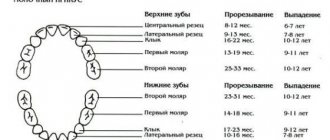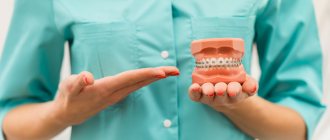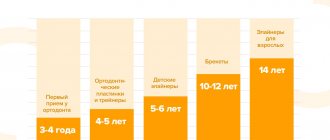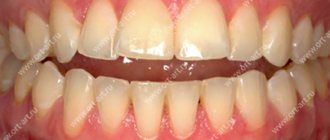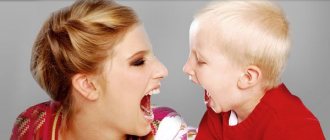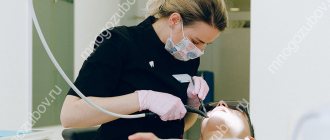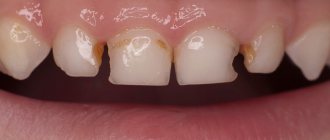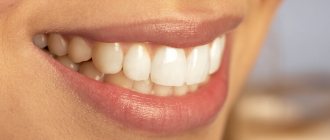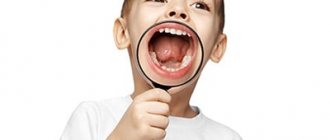Malocclusion in a child is a pathology in which one row of teeth deviates relative to another, which violates the anatomical norm, and occlusion is disrupted (the teeth do not close correctly when the jaws are brought together). Malocclusion is not considered to be the curvature of the dentition due to the incorrect position of individual teeth.
- Causes
- Symptoms
- Diagnosis of malocclusion in children
- Treatment
- Correction
- Prevention of malocclusion in children
- Prognosis of malocclusion in a child
Causes
A child's malocclusion may have hereditary roots. If parents' jaws are anatomically incorrect, most likely their child will experience the same thing. Bite abnormalities appear gradually. In infants, the jaws consist mainly of the alveolar process, and their basal parts are still underdeveloped. At the same time, the bones of the upper jaw grow faster than the lower jaw, and the lower jaw has two halves that fuse when the child turns 1 year old (on average).
The jaws change, which is reflected in the bones and muscles, including the temporal, chewing and pterygoid. The most developed muscle in babies is the chewing muscle, because they need it to suck on their mother's breast. But the lateral and medial pterygoid, as well as the temporal muscles, thanks to which the lower jaw moves up and down and back and forth, are poorly developed during this period. And after the first teeth have erupted, they begin to actively develop. A child from 1 year of age begins to experience malocclusion.
Factors that influence bite problems in children:
- artificial feeding of a newborn (sucking a bottle is easier than extracting milk from the mother’s breast, therefore the muscles of the jaw and face develop less than they should at this age)
- use of a pacifier up to 1.5-2 years (during this period the baby is teething)
- after the eruption of primary molars, the child’s diet lacks food that must be chewed before swallowing
- baby's habit of holding and sucking fingers or toys
From 5-7 months of life, the child’s upper central incisors are also cut. This is the beginning of the formation of the baby rows of teeth. In cases where the upper jaw is more developed than the lower jaw, or the teeth are small, the spaces between the teeth (three teeth) can be more than 1 mm in size. This is a signal of future problems with the child's bite.
When a baby turns 3-4 years old, the bone structures of his teeth and jaws are actively forming. From the age of 5, the gradual resorption of the roots of baby teeth and the growth of the alveolar processes of the jaws begin. From the age of six, baby teeth fall out and molars grow in their place.
Orthodontists call replacement teeth those that a child has until the age of 13-14 years. During the same period, the size of the jaws also changes, because their basal part is actively growing. If deviations occur during this period, they may precede a malocclusion. The twisting of individual teeth relative to their axis or erupting them in the wrong place is almost a guarantee that the child will develop a malocclusion. Violation of occlusion in children has a main cause - an anomaly in the shape of the dental arches.
The cause of malocclusion may be hidden in the syndrome of chronic difficulty in nasal breathing in various diseases of the ENT organs or congenital pathologies of the nasopharynx and nasal septum:
- enlarged adenoids
- polypous rhinosinusitis
- sinusitis
- rhinitis
With such pathologies, the child breathes through his mouth, even in his sleep. Therefore, the muscles responsible for lowering the lower jaw do not relax at night, the upper jaw is pulled forward, and therefore the bite is disturbed. The proportions of the face change, which is called the adenoid type of the child’s face.
Endocrinologists say that bite defects can be a consequence of functional disorders of the thyroid and parathyroid glands. In particular, due to a lack of production of thyroxine and thyrocalcitonin, bone growth is delayed. The maxillofacial bones also grow poorly, and the child’s baby teeth are cut slowly and belatedly. When the parathyroid glands are underdeveloped or diseased, the production of parathyroid hormone, which regulates calcium levels in the body, is disrupted. Impaired calcium metabolism causes demineralization of bone tissue, which can cause the jaws to lose their normal anatomical shape and location.
Symptoms
An incorrect bite is always visible visually. And the symptoms depend on the type of dental anomaly. Malocclusion in children can be distal: maxillary and alveolar prognathia. The first of these is manifested by a strongly developed upper jaw protruding forward. In this case, the upper dental arch is expanded, and the upper teeth overlap the crowns of the lower dentition by more than a third.
The alveolar leaf bite is special in that only that part of the bone where the tooth sockets are located protrudes forward. When a child with such a defect smiles, not only the upper teeth are visible, but also to a large extent the alveolar zone of the gum. With a mesial bite, the lower jaw, which is more developed than normal, protrudes forward, so the lower row of teeth “overlaps” the upper one. When a child has such a pathology, it is difficult for him to bite off food, and there may also be incorrect articulation to a greater or lesser extent.
Vertical incisal disocclusion (or deep bite) is visible visually and also audible. The upper jaw may be too narrow and the middle of the lower jaw too flat. This explains the short lower part of the face. The child pronounces hissing sounds incorrectly because the upper incisors deeply overlap the central part of the lower jaw. There are also problems with biting.
An open bite is diagnosed if several chewing teeth of the upper and lower jaws do not close together and there is a large gap between their surfaces. These children's mouths are slightly open almost all the time; they have difficulty biting when eating because the front teeth do not close together. The lower labial fold is absent in almost all cases. It is difficult for a child to hold his tongue in an anatomically normal position, and therefore his speech is distorted.
Crossbite in children is manifested by the following symptoms:
- unilateral underdevelopment of the lower jaw
- difficulty moving the lower jaw to the left and right
- biting the soft tissue of the cheeks
- violation of facial symmetry with strong displacement of the lower jaw from the anatomically normal position
When does a child need to have their bite corrected?
You can be of any age to correct your bite. Treatment can begin at 3-4 months. You can notice a malocclusion in an infant by abnormal breathing: it is often difficult. During feeding, you need to pay attention to the position of the baby's head: it should not be thrown back or pressed with the chin to the chest.
In children under 2 years of age, the facial muscles are poorly developed, so it is impossible to recognize an incorrect bite without consulting a specialist. In this case, hardware techniques are not used; the child can be prescribed physiotherapeutic procedures and massage.
In children over 5 years of age, disorders are clearly visible. The child's speech may be impaired, as well as chewing function. The defect can be seen upon visual inspection: the teeth grow incorrectly (displaced, crowded). The child has asymmetry of the jaw or face (partial closure, protruded lower or upper jaw).
If the molars grow incorrectly, the child may complain of headaches, constant biting on the inside of the cheeks and clicking in the temples.
Diagnosis of malocclusion in children
For diagnosis, the child must be taken to an orthodontist. He performs an oral examination. The doctor takes into account the proportions of the face, for which the width of the dental arches, the angle of the occlusal plane and other indicators are determined. If a child has trouble breathing through the nose, an ENT consultation is needed to treat diseases of the paranasal sinuses, nose and adenoids to restore normal breathing.
To accurately determine the number of teeth and their location in the dentition, as well as the location of the jaws relative to each other, the characteristics of muscle tissue and the condition of the temporomandibular joint, computer 3D cephalometry and a panoramic x-ray of the dental system, which is also known as an orthopantomogram, are performed.
The examination must be comprehensive so that the specialist can establish the relationship between the width of the upper and lower dental, alveolar and basal arches. Normal anatomy is that the maxillary dental arch should be wider than the alveolar arch. Normally, the alveolar arch should be wider than the basal arch. And for the lower jaw it’s the other way around. After determining the size characteristics of all elements of the jaw in each case, the doctor creates a diagnostic model of the jaws, which is used to determine the type of deviation of the maxillofacial structures and the type of occlusion disorder in the child.
Diagnostics
Even if parents carefully monitor all the signs of malocclusion in their child, they will not notice them at the initial stage. This can only be done effectively by a dentist, to whom the boy or girl should be taken for preventive examinations every six months. This period is enough for the bite to begin to change, but not to deform significantly. Such examinations can begin at the age of two.
If problems are detected, the dentist will refer the patient for a consultation with a pediatric orthopedist. A visit to an otolaryngologist, speech therapist, or periodontist may also be necessary.
Comprehensive diagnostics may include the following components:
- panoramic image (orthopantomogram);
- X-ray of the skull in a lateral projection (teleroentgenogram);
- photo of the face in front and profile;
- making a model of the dentition based on a cast;
- computed tomography of the temporomandibular joint;
- myography of facial muscles.
All data obtained will allow us to determine the size of the problem and develop a treatment regimen.
Treatment
Treatment of malocclusion is called orthodontic treatment, and it takes a long time. The treatment method depends on the type of malocclusion in the child. The younger the child is, the easier it will be to correct bite defects. In most cases, removable pre-orthodontic trainers, plates, mouth guards or elasto-aligners are used. Soft and hard trainers should be worn during the daytime and at night for 1-1.5 hours. They help wean children two to five years old from bad habits (sucking the tongue and sticking it between the teeth or biting the lower lip). Trainers help teeth erupt correctly and straighten the front incisors when they grow crookedly.
Custom-made removable dental guards made from polycarbonate are called dental trays or aligners (elasto-aligners). They are used mainly to correct the bite in children from 6 to 12 years old, if the forearms are twisted, excessively tilted forward or into the oral cavity. Mouthguards are worn 2-3 hours a day or more.
Braces are non-removable structures that are attached to a child’s permanent teeth. They must straighten the teeth and dentition due to constant pressure on the alveolar arches of the jaw from special arches that are fixed in the grooves of the braces. Braces are worn from 12 to 26 months (depending on how crooked the child’s teeth are). When braces are removed, retention plates are installed to help keep the teeth where they are when straightened. The period of wearing these plates can be up to 3 years. For alveolar prognathia, braces are used for treatment, but they are not relevant if the child has other types of occlusion disorders.
Care and hygiene rules
One of the advantages of aligners is their ease of care. To keep them clean and effective throughout the correction, follow these simple rules:
- aligners must be worn up to 22 hours a day, depending on the orthodontist's indications, removing them only for eating or oral hygiene;
- The aligner must be cleaned regularly by rinsing the inner surface with warm running water and brushing with a toothbrush;
- You should avoid too hot water so that the polymer does not deform due to temperature changes.
Aligners do not require special solutions. If you remove them, then put them in a special clean and sealed box, protected from dust and moisture.
Oral hygiene when wearing aligners also remains the same - brush, paste, mouth rinse solutions and dental floss. The latter is also suitable for effectively removing food particles.
Let us note the contraindications under which aligners cannot be installed:
- periodontal disease. Like other methods of orthodontic treatment, aligners are not prescribed for periodontal disease due to the high risk of losing teeth due to destruction of periodontal tissue;
- severe deformation of the jaw. Aligners work well for minor malocclusions. However, serious defects require surgery;
- in the presence of impacted teeth. Often this problem occurs with molars that do not erupt and remain in the gum or even in the jaw bone. Having an aligner can interfere with their development and lead to problems in the future;
- if 4 or more teeth have been lost.
In other cases, aligners are equally effective for all ages - from children to adults.
Expert of the article you are reading:
Pokrovskaya Natalya Sergeevna
Head of the Department of Orthodontics
Specialization: Invisalign bite correction, neuromuscular diagnostics, pediatric orthodontics.
Free consultation
Correction
With a distal bite, the development of the apical points of the alveolar and basal arches of the upper jaw is restrained, and the growth of the child’s lower jaw is activated. For this purpose, during the period of loss of baby teeth, the following devices can be used:
- Andresen activator
- Engle's arc apparatus
- Ainsworth arc apparatus
- Herbst arc apparatus
- functional Frenkel apparatus of the first or second type
Removable plates are placed on the teeth, and a vestibular retraction arch helps reduce tremors. Also, the goal of treatment is to give the desired direction to the growth of the maxillofacial bones. To do this, a facebow is installed outside, which the child wears at home; there is no need to wear it to school.
Correction of mesial bite
The goal of treating such a malocclusion is to correct the protrusion of the lower jaw or promote the development of the upper jaw. For this purpose the following devices are used:
- Frenkel activator type III
- removable Andresen-Goipl apparatus
- Klammt activator
- Wunderer or Delaire apparatus
- orthodontic cap with chin sling bandage
- Adams, Nord or Schwartz records
- single-jaw stationary Angle arch
In order to inhibit the growth of the bone structures of the lower jaw, children 13-14 years old can undergo dental surgery. During this procedure, the buds of the lower eighth teeth, the so-called wisdom teeth, which begin to grow when the child is between the ages of 6 and 14, are removed.
Correction of deep bite
It takes a lot of effort to correct this effect when a child has baby teeth. In practice, it turns out that improper closure occurs again in a child after the appearance of permanent teeth. Treatment of deep bite involves preschool children performing special exercises, the purpose of which is to develop the medial and lateral pterygoid muscles, which push the lower jaw forward. To coordinate pressure on the teeth of the lower row, the following devices are used:
- Andresen's plate apparatus
- bite blocks
- Klammt activator
- fixed orthodontic devices of various designs
Open bite correction
If a child has an open bite, in most cases the upper jaw is narrowed. For this reason, removable expansion plates of various modifications are used, equipped with a spring or screw for children whose permanent teeth have just begun to emerge. They are used for treatment and construction to increase the anterior parts of the upper alveolar arch, to reduce the lateral parts of the alveolar zones, which is selected individually in each case.
If the discrepancy between the incisors and canines is large, for children over 12 years of age, intermaxillary traction techniques using Angle orthodontic devices with additional traction can be used. The second way of correction is the use of plastic mouth guards, which are placed on both jaws (front teeth).
Crossbite correction
The purpose of treatment: to establish the most correct arrangement of teeth in the row and the position of the child’s lower jaw. If a child with baby teeth has a crossbite, it is necessary to separate the dentition. To do this, crowns or trays are installed on the molars, as well as on the lateral teeth - plate devices with bite plates.
In cases of cross occlusion and severe lateral displacement of the lower jaw, a chin sling is sometimes used. Plate devices, adjustable with screws and springs, are suitable for expanding the dental, alveolar and basal arches of the child’s jaws.
Types of violations
Orthodontists distinguish several types in which unsatisfactory occlusion is observed. There are such malocclusions:
- Distal. The lower jaw is shifted forward, the face takes on an overly surprised or perplexed expression.
- Mesial. The mandibular bone is significantly shifted forward relative to the upper one or the upper one is underdeveloped (has a reduced size).
- Cross . The closure occurs like scissors - the teeth in certain areas close in the opposite ratio.
- Deep. The upper dentition completely covers the antagonists.
- Open . In some areas there is no occlusion; even when the jaws are completely closed, a gap remains.
Prevention of malocclusion in children
Prevention of malocclusion should begin with breastfeeding a newborn. If this is not possible, it is necessary that the hole in the nipple on the bottle with milk formula is small, and that the nipple itself is in the child’s mouth at a right angle to the nasolabial plane and chin and does not put pressure on the gums. Then the child’s facial muscles will develop normally.
Choose pacifiers of shapes that correspond to the anatomical structure of the baby’s oral cavity. It is better that the child does not suck a pacifier while sleeping. You need to stop sucking a pacifier when you reach 1.5 years of age. Wean your baby from the habit of biting his lips, sucking fingers and toys.
Prevention of open bite is that the baby should sleep so that his head is slightly higher than his body. Children should breathe freely through their nose while sleeping, keeping their mouth closed. If a child does not have a cold, but cannot breathe normally through his nose, it is worth going to an otolaryngologist for an appointment. When a child has already cut 8-10 teeth, you cannot feed him crushed food. For normal development of the maxillofacial muscles, he must bite off and chew food on his own.
Myogymnastics is relevant for children 2.5-3 years old. These are exercises that help develop the muscles of the jaws and face. The orthodontist should tell you about the technique, because each type of malocclusion requires special exercises.
Correction of bite at different ages
Before talking about age and methods suitable for eliminating malocclusion, you need to understand how it is formed.
The formation of a bite in children occurs in several stages:
- 1
Up to 6 months – sucking skill promotes proper growth and development of the jaws.
- 2
From six months (from the first tooth) to 3 years – the formation of the bite of temporary teeth.
- 3
3-6 years – laying the foundation for the appearance of permanent teeth (intensive growth of the jaw bone).
- 4
6-12 years – the period of replacement of milk teeth with permanent ones. During this period, the jaw continues to actively grow.
- 5
12-16 years – the final stage of formation of a permanent bite.
Correction of bite in infants (up to 1 year)
At this stage, it is impossible to apply any of the existing methods of bite correction. Moreover, it is too early to talk about an accurate diagnosis of the problem. The doctor can only assume the likelihood of a violation if the parents have a similar problem. The only active method of treatment that is used for children under 3 years of age is plastic surgery of the frenulum of the lips and tongue.
Basically, exclusively preventive measures are used:
- breastfeeding up to a maximum of 1 year;
- adherence to the schedule for introducing complementary foods (thicker and tougher foods);
- use of orthodontic pacifiers;
- correction of habits - you need to make sure that while sleeping the child does not prop his cheek with his hand or throw his head back;
- observation in dentistry - from the appearance of the first tooth, regularly bring the baby for examination to a pediatric dentist and promptly treat caries.
Bite correction at 3-6 years old
Starting from the age of three, active correction methods are already used in orthodontic treatment:
- fighting bad habits (weaning off pacifiers, etc.);
- facial gymnastics;
- the use of a vestibular shield - a plate that promotes the support and development of muscles, prevents the child from putting a pacifier, foreign objects, or thumb sucking in his mouth;
- prosthetics for prematurely lost primary teeth.
7-11 years
Once the child reaches 7 years of age, the doctor will suggest using various orthodontic structures to correct irregularities in the dentition:
- records;
- trainers;
- mouth guards
Orthodontic treatment at 12-16 years old
When the process of bite formation is completed, that is, the active growth of the jaw has ended, all permanent teeth have fully erupted, except for aligners and conventional plates, braces are used in treatment.
Which method is the safest and most effective for a child? Only an orthodontist can answer this question after an examination and comprehensive diagnosis.
Prognosis of malocclusion in a child
If measures are not taken to normalize the position of the jaws, it becomes increasingly difficult for the child to bite off food and chew because the teeth do not close as needed. This problem is especially relevant in mesial, open and cross bites. If food is not crushed enough, this can lead to future gastrointestinal diseases.
If a child is diagnosed with a distal bite, the back molars will be overloaded, causing them to wear out prematurely and also damage the enamel. Any malocclusion in children threatens dysfunction of the temporomandibular joints. If your bite is severely misaligned, your nerves can become pinched, causing severe pain. And, of course, an incorrect bite in a child greatly affects articulation; diction can be impaired throughout life.
How to determine
In order to identify a malocclusion in your child, you can focus on a number of signs that not only specialists, but also parents can see. The main ones:
- asymmetry of the face from the front (between the right and left halves, especially in the area of the nasolabial triangle and chin);
- extra or missing teeth;
- untimely teething or change of dental sets;
- crowded dentition;
- excessive tension of the chin and lips during swallowing;
- frequent snoring or grinding in sleep;
- constantly slightly open mouth in the absence of nasal congestion;
- poor posture;
- frequent injuries to the tongue or cheeks.
